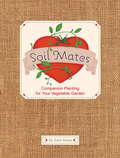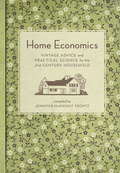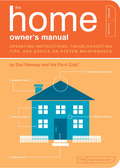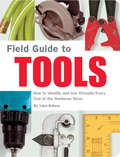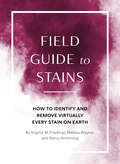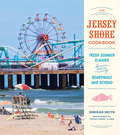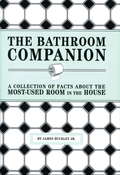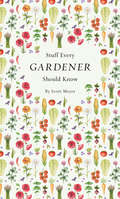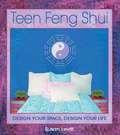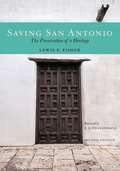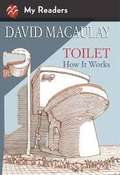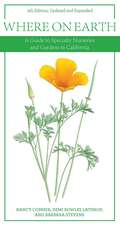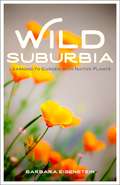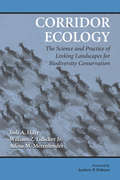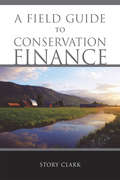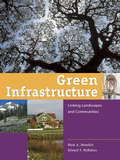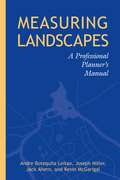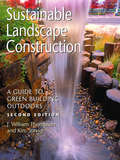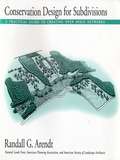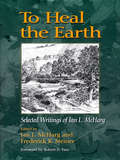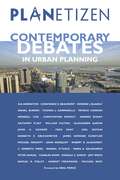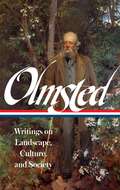- Table View
- List View
Soil Mates
by Kelle Carter Sara AlwayMatchmaking in the garden! In this charming guide to companion planting for your vegetable-garden favorites, you'll learn why Broccoli Rosemary and whether Cucumber + Corn = friends with benefits. (Just watch out for Celery! Leggy and leafy, she is notoriously easygoing and will happily settle down with just about anyone, raising a ruckus in your raised beds.) Complete with 20 pairings, tasty recipes, prep-aration tips, and more, Soil Mates is the perfect partner for your horticultural matchmaker.
Home Economics
by Jennifer Mcknight Trontz"Housekeeping is becoming more and more a matter of science, and the laurels are bound to fall to the woman who conducts her household in a business-like way." Let the thrifty sensibility of yesteryear be your guide as you shop for the most economical foods, choose wall colors scientifically, clean with natural products, look your best without breaking the bank, and budget your way to frugal efficiency. In this amazing collection of clever wisdom and practical advice drawn from vintage home-economics textbooks, you'll find everything you need to get back to basics and run a healthy and happy household. Home Economics covers all the categories of delightful domesticity: * Health & Hygiene * Cookery & Recipes * Manners & Etiquette * Design & Decoration * Cleaning & Safety * Gardening & Crafts Rediscover the art and science of keeping house--economically!
The Home Owner's Manual
by Dan Ramsey The Fix-It Club Jude Buffum Paul KeppleAt Last! A Beginner's Guide to Home Technology Water stains on your ceiling. Dents and cracks in your drywall. Radiators that hiss and gurgle all night long. It's enough to make you cry out, "Why doesn't my house come with an owner's manual?" And now--finally!--it does. Through step-by-step instructions and helpful schematic diagrams, The Home Owner's Manual explores hundreds of frequently asked questions: What's the best way to fix a leaky faucet? When should I have my chimney cleaned? How can I reset a circuit breaker without electrocuting myself? Whatever your concerns, you'll find the answers here--courtesy of licensed building contractor Dan Ramsey, who has taught the basics of renovation to thousands of homeowners.
Field Guide to Tools
by John KelseyFinally, a field guide to identifying and utilizing more than 100 tools, from an awl to a propane torch, from a table saw to a screwdriver! Field Guide to Tools is the ultimate guide to all the gear any handyperson requires. Hardware stores, home stores, and garden stores are full of unrecognizable items--here's how you can find out what tool is appropriate for your job and just how to go about employing it. Descriptive pages outline the basic history and use for each tool, inventive alternate functions, and operating principles; component parts are illustrated by helpful diagrams; and more than 100 full-color photographs aid in identification while at the hardware store. Step-by-step directions walk you through the basics of using each tool properly and safely. Don't attempt another at-home fix-it project without Field Guide to Tools!
Field Guide to Stains: How to Identify and Remove Virtually Every Stain on Earth (Field Guide)
by Nancy Armstrong Melissa Wagner Virginia M. FriedmanAt last, a field guide to identifying and doing battle with more than 100 stains, from tomato juice to tar, from avocado to urine! Field Guide to Stains is divided into handy sections for easy access to information when time is of the essence: Fruits and Vegetables, Meat and Protein, Household Items, Garage and Yard, and more. Readers will learn more than just removal techniques--details include general descriptions and likely seasons, times, and areas of occurrence. Did you know that a yogurt stain is more likely to occur in January (when New Year's resolutions demand more healthy eating), and that correction fluid stains are more prevalent in April (when the pressure to complete your taxes on time is at a high)? Includes more than 100 full-color photographs of stains, each one cross-referenced to its description and step-by-step removal advice. Quick-reference icons guide the reader to the most essential information in each entry. This guide has a sturdy, stain-proof exterior--making it a necessity for every cubicle, glove compartment, and college dorm. Field Guide to Stains is a must-have for everyone about to venture out into the wild, to the kitchen, or to a night on the town!
The Jersey Shore Cookbook: Fresh Summer Flavors from the Boardwalk and Beyond
by Deborah Smith Photography by Thomas Robert ClarkeCoastal cuisine from Asbury Park to Cape May. The warm sand. The salt air. The boardwalk. The food! Summer at the Jersey Shore is unforgettable no matter which seaside destination is yours. And with The Jersey Shore Cookbook, you can have a taste of summer all year long. It features 50 recipes contributed by well-loved shore town restaurants, bakeries, markets, and more. From fresh oysters, scallops, and tilefish to Garden State tomatoes, corn, and blueberries, the perfect New Jersey ingredients shine. Featuring favorites from: Asbury Park Atlantic City Avalon Bay Head Beach Haven Belmar Bradley Beach Brielle Cape May Cape May Point Harvey Cedars Highlands Keyport Lavallette Leeds Point Long Branch Manasquan Monmouth Beach Normandy Beach Ocean City Point Pleasant Beach Sea Bright Sea Girt Sea Isle City Ship Bottom South Seaside Park Stone Harbor Wildwood Wildwood Crest Selected Recipes: BREAKFASTS The Brunchwich: Pork Roll The Committed Pig, Manasquan Grilled Jersey Peaches with Greek Yogurt and Granola Lasolas Market, Normandy Beach STARTERS AND SIDES Allagash Steamers Marie Nicole's, Wildwood Crest Oysters Gratineé Fratello's Restaurant, Sea Girt SOUPS AND SALADS Roasted Tomato and Basil Soup Langosta Lounge, Asbury Park Beach Plum Farm Salad The Ebbitt Room, Cape May MAIN COURSES Golden Tilefish Sandwich Joe's Fish Co., Wildwood Lobster Thermidor Knife and Fork Inn, Atlantic City Spaghetti and Crabs Joe Leone's Italian Specialties, Point Pleasant Beach DESSERTS Blueberry Cobbler Talula's, Asbury Park Key Lime Pie Inlet Café, Highlands
The Bathroom Companion
by James BuckleyIt's the most used room in the house--but how much do you know about it? Here's the first book about the bathroom written exclusively for the bathroom! Set it on the back of the tank and learn something new on every visit--amazing facts and figures from history, science, pop-culture, and more. Don't let you time in the bathroom be a waste!
Stuff Every Gardener Should Know
by Scott MeyerThe latest in the best-selling Stuff series, Stuff Every Gardener Should Know is the perfect pocket guide to your garden! What’s the difference between heirlooms and hybrids? How can I stop weeds from invading my flowerbeds? And what’s the best way to attract helpful, beneficial insects? All these questions and more are answered in Stuff Every Gardener Should Know—a handy little reference book that’s perfect for gardeners of all ages and experience. From the secrets of indoor seed-starting to tips for hassle free roses, this delightful companion is blooming with fun facts and helpful ideas.From the Hardcover edition.
Teen Feng Shui: Design Your Space, Design Your Life
by Susan LevittA feng shui book specifically for teens.• Shows how to create balanced teen environments that promote personal development and positive self expression.• Tailors solutions to teen spaces: bedrooms, dormitories, desks, drawers, and lockers.• Shows how, when, and where to use music, incense, and posters.• Addresses real teen issues such as body image, tattoos and piercings, and cigarettes and other drugs.Teen Feng Shui demonstrates how the universal principles behind the design practice of feng shui can be applied to the contemporary environments of teenagers--from school lockers to dorm rooms--in order to maximize personal power, develop harmonious relationships, and define personal space. Noting that all books on feng shui are created for adults, Susan Levitt has provided a resource geared specifically toward the needs and realities of the teenage experience, addressing how young adults can design their living spaces to transform their lives. She describes how music, posters, and incense can influence space and includes before-and-after illustrations of feng shui "fixes." Teen Feng Shui also incorporates Chinese astrology, financial management and shopping tips for teens, insights on love and sex, personal stories, and case studies to provide a fun and comprehensive guide to this ancient art of placement.
Saving San Antonio: The Preservation of a Heritage
by Lewis F. FisherFew American cities enjoy the likes of San Antonio's visual links with its dramatic past. The Alamo and four other Spanish missions, recently marked as a UNESCO World Heritage site, are the most obvious but there are a host of landmarks and folkways that have survived over the course of nearly three centuries that still lend San Antonio an "odd and antiquated foreignness." Adding to the charm of the nation's seventh largest city is the San Antonio River, saved to become a winding linear park through the heart of downtown and beyond and a world model for sensitive urban development. San Antonio's heritage has not been preserved by accident. The wrecking balls and headlong development that accompanied progress in nineteenth-century San Antonio roused an indigenous historic preservation movement-the first west of the Mississippi River to become effective.Its thrust has increased since the mid-1920s with the pioneering work of the San Antonio Conservation Society. In Saving San Antonio, Texas historian Lewis Fisher peels back the myths surrounding more than a century of preservation triumphs and failures to reveal a lively mosaic that portrays the saving of San Antonio's cultural and architectural soul. The process, entertaining in the telling, has reverberated throughout the United States and provided significant lessons for the built environments and economies of cities everywhere.
Juan O'Gorman: A Confluence of Civilizations
by Catherine Nixon CookeTo create the "Confluence of Civilizations" mural commissioned for the 1968 World's Fair in San Antonio, Texas, Juan O'Gorman collected natural stones from all over Mexico-twelve colors in all-field stones that the artist knew would never fade or change their hue. Juan O'Gorman: A Confluence of Civilizations follows the life of Juan O'Gorman and covers the creation of this spectacular piece of midcentury public art that stands the test of time not just in vibrancy but as one of the most influential works created by a storied Mexican artist.Juan O'Gorman was a not only a painter and a muralist, a mosaic artist, a critic, and a professor, but he was also an architect and a revolutionary; possibly most famous for his close friendship with Diego Rivera and Frida Kahlo and as designer of their infamous two-house studio in Mexico City-Casa Azul-linked by a symbolic bridge.To celebrate San Antonio's "HemisFair" Exposition in 1968, Juan created the giant mosaic mural that still adorns one wall of the Lila Cockrell Theater along San Antonio's famed River Walk. The design plans for the five ton mosaic measured 2600 square feet and consisted of 540 numbered panels, each weighting about 90 pounds.
Toilet: How It Works (My Readers #3)
by David MacaulayEveryone knows what a toilet is for, right? But what exactly happens after you flush? Where does our waste go, and how is it made safe? With his unique blend of informative text and illustration, David Macaulay takes readers on a tour of the bathroom, plumbing, and the sewer system, from the familiar family toilet to the mysterious municipal water treatment plant.
Where on Earth: A Guide to Specialty Nurseries and Gardens in California
by Nancy Conner Barbara Stevens Demi LathropEver since its initial publication in 1993, this guide to California's specialty plant nurseries has been an invaluable tool for gardeners and landscapers, and it is now available in an expanded and completely revised edition. Organized by geographic region, each listing provides essential information, including address, contact information, hours, plant offerings, and a detailed description of the facility and its owners. In addition to featuring specialty nurseries, Where on Earth catalogs notable garden centers, plant societies, education programs, and horticultural attractions throughout the state, as well as mail-order sources for bulbs, seeds, and rhizomes. The coauthors also include twelve essays, one for each region, that address that area's special features and gardening concerns. Whether you're searching for antique roses on the foggy North Coast, water-wise succulents and native shrubs around Los Angeles, or a palm doctor for your sickly cycads in the Central Valley, this book gives current, detailed advice for plant lovers to see, shop, and savor.
Wild Suburbia: Learning to Garden with Native Plants
by Barbara EisensteinWild Suburbia guides us through the process of transforming a traditional, high water-use yard into a peaceful habitat garden abounding with native plants. Author Barbara Eisenstein emphasizes that gardening is a rewarding activity rather than a finished product, from removing lawns and getting in touch with a yard's climate to choosing plants and helping them thrive. Supplementing her advice with personal stories from her decades of experience working with native plants, Eisenstein illuminates the joys of tending a native garden-and assures us that any challenges, from managing pests to disapproving neighbors, should never sap the enjoyment out of a pleasurable and fulfilling hobby. For plant lovers curious about their own ecosystems, Wild Suburbia offers a style of gardening that nurtures biodiversity, deepens connection to place, and encourages new and seasoned gardeners alike to experiment and have fun.
Trails for the Twenty-First Century: Planning, Design, and Management Manual for Multi-Use Trails
by Kristine Olka Robert Rails to Trails Conservancy Charles Flink David Burwell Robert SearnsCommunities across the country are working to convert unused railway and canal corridors into trails for pedestrians, cyclists, horseback riders, and others, serving the needs of both recreationists and commuters alike. These multi-use trails can play a key role in improving livability, as they offer an innovative means of addressing sprawl, revitalizing urban areas, and reusing degraded lands. Trails for the Twenty-First Century is a step-by-step guide to all aspects of the planning, design, and management of multi-use trails. Originally published in 1993, this completely revised and updated edition offers a wealth of new information including. *discussions of recent regulations and federal programs, including ADA and TEA-21 *recently revised design standards from AASHTO *current research on topics ranging from trail surfacing to conflict resolution *information about designing and building trails in brownfields and other *environmentally troubled landscapes Also included is a new introduction that describes the importance of rail-trails to the sustainable communities movement, and an expanded discussion of maintenance costs. Enhanced with a wealth of illustrations, Trails for the Twenty-First Century provides detailed guidance on topics such as: taking a physical inventory and assessment of a site; involving the public and meeting the needs of adjacent landowners; understanding and complying with existing legislation; designing, managing, and promoting a trail; and where to go for more information. It is the only comprehensive guidebook available for planners, landscape architects, local officials, and community activists interested in creating a multi-use trail.
Corridor Ecology: The Science and Practice of Linking Landscapes for Biodiversity Conservation
by Adina Merenlender Jodi A. Hilty Andrew P. Dobson William Z. Lidicker Jr.Corridor Ecology presents guidelines that combine conservation science and practical experience for maintaining, enhancing, and creating connectivity between natural areas with an overarching goal of conserving biodiversity. It offers an objective, carefully interpreted review of the issues and is a one-of-a-kind resource for scientists, landscape architects, planners, land managers, decision-makers, and all those working to protect and restore landscapes and species diversity.
A Field Guide to Conservation Finance
by Roger C. Altman Story ClarkFinally, a comprehensive book on land conservation financing for community and regional conservation leaders. A Field Guide to Conservation Finance provides essential advice on how to tackle the universal obstacle to protecting private land in America: lack of money. Story Clark dispels the myths that conservationists can access only private funds controlled by individuals or that only large conservation organizations have clout with big capital markets. She shows how small land conservation organizations can achieve conservation goals using both traditional and cutting-edge financial strategies. Clark outlines essential tools for raising money, borrowing money, and reducing the cost of transactions. She covers a range of subjects including transfer fees, voluntary surcharges, seller financing, revolving funds, and Project Related Investment programs (PRIs). A clear, well-written overview of the basics of conservation finance with useful insights and real stories combine to create a book that is an invaluable and accessible guide for land trusts seeking to protect more land.
Green Infrastructure: Linking Landscapes and Communities
by Edward T. Mcmahon Lydia Bergen Mark A. Benedict Mark A. The Conservation FundWith illustrative and detailed examples drawn from throughout the country, Green Infrastructure advances smart land conservation: large scale thinking and integrated action to plan, protect and manage our natural and restored lands. From the individual parcel to the multi-state region, Green Infrastructure helps each of us look at the landscape in relation to the many uses it could serve, for nature and people, and determine which use makes the most sense. In this wide-ranging primer, leading experts in the field provide a detailed how-to for planners, designers, landscape architects, and citizen activists
Measuring Landscapes: A Planner's Handbook
by Jack Ahern Joseph Miller Kevin Mcgarigal Andre Botequilha LeitaoThis practical handbook bridges the gap between those scientists who study landscapes and the planners and conservationists who must then decide how best to preserve and build environmentally-sound habitats. Until now, only a small portion of the relevant science has influenced the decision-making arenas where the future of our landscapes is debated and decided. The authors explain specific tools and concepts to measure a landscape's structure, form, and change over time. Metrics studied include patch richness, class area proportion, patch number and density, mean patch size, shape, radius of gyration, contagion, edge contrast, nearest neighbor distance, and proximity. These measures will help planners and conservationists make better land use decisions for the future.
Sustainable Landscape Construction: A Guide to Green Building Outdoors, Second Edition
by J. William Thompson Kim SorvigPublished at the beginning of the twenty-first century, Sustainable Landscape Construction took a new approach to what was then a nearly new subject: how to construct outdoor environments based on principles of sustainability. This enormously influential book helped to spur a movement that has taken root around the U.S. and throughout the world. The second edition has been thoroughly updated to include the most important developments in this landscape revolution, along with the latest scientific research in the field. It has been expanded to provide even more ideas for designing, building, and maintaining environmentally sensitive landscapes. It is essential reading for everyone with an interest in "green" landscape design. Like its predecessor, the new edition of Sustainable Landscape Construction is organized around principles that reflect the authors' desire to put environmental ethics into practice. Each chapter focuses on one over-arching idea. These principles of sustainability are clearly articulated and are developed through specific examples. More than 100 projects from around the globe are described and illustrated. A new chapter details ways in which landscape architectural practice must respond to the dangers posed by fire, floods, drought, extreme storms, and climate change. Sustainable Landscape Construction is a crucial complement to basic landscape construction texts, and is a one-of-a-kind reference for professionals, students, and concerned citizens.
Conservation Design for Subdivisions: A Practical Guide To Creating Open Space Networks
by Randall G. ArendtIn most communities, land use regulations are based on a limited model that allows for only one end result: the production of more and more suburbia, composed of endless subdivisions and shopping centers, that ultimately covers every bit of countryside with "improvements." Fortunately, sensible alternatives to this approach do exist, and methods of developing land while at the same time conserving natural areas are available. In Conservation Design for Subdivisions, Randall G. Arendt explores better ways of designing new residential developments than we have typically seen in our communities. He presents a practical handbook for residential developers, site designers, local officials, and landowners that explains how to implement new ideas about land-use planning and environmental protection. Abundantly illustrated with site plans (many of them in color), floor plans, photographs, and renditions of houses and landscapes, it describes a series of simple and straightforward techniques that allows for land-conserving development. The author proposes a step-by-step approach to conserving natural areas by rearranging density on each development parcel as it is being planned so that only half (or less) of the buildable land is turned into houselots and streets. Homes are built in a less land-consumptive manner that allows the balance of property to be permanently protected and added to an interconnected network of green spaces and green corridors. Included in the volume are model zoning and subdivision ordinance provisions that can help citizens and local officials implement these innovative design ideas.
To Heal the Earth: Selected Writings Of Ian L. McHarg
by Robert Yaro Frederick R. Steiner Ian L. MchargIan L. McHarg's landmark book Design with Nature changed the face of landscape architecture and planning by promoting the idea that the design of human settlements should be based on ecological principles. McHarg was one of the earliest and most influential proponents of the notion that an understanding of the processes that form landscapes should underlie design decisions. In To Heal the Earth, McHarg has joined with Frederick Steiner, a noted scholar of landscape architecture and planning, to bring forth a valuable cache of his writings produced between the 1950s and the 1990s. McHarg and Steiner have each provided original material that links the writings together, and places them within the historical context of planning design work and within the larger field of ecological planning as practiced today. The book moves from the theoretical-beginning with the 1962 essay "Man and Environment" which sets forth the themes of religion, science, and creativity that emerge and reappear throughout McHarg's work--to the practical, including discussions of methods and techniques for ecological planning as well as case studies. Other sections address the link between ecology and design, and the issue of ecological planning at a regional scale, covering topics such as education and training necessary to develop the field of ecological planning, how to organize and arrange biophysical information to reveal landscape patterns, the importance of incorporating social factors into ecological planning, and more. To Heal the Earth provides a larger framework and a new perspective on McHarg's work that brings to light the growth and development of his key ideas over a forty year period. It is an important contribution to the literature, and will be essential reading for students and scholars of ecological planning, as well as for professional planners and landscape architects.
Planetizen's Contemporary Debates in Urban Planning
by Abhijeet Chavan Christian Peralta Christopher Steins Abhijeet PlanetizenPlanetizen's Contemporary Debates in Urban Planning is a fascinating review of major topics and issues discussed in the field of urban planning, assembled by editors at Planetizen, the leading source of news and information for the planning and development community on the web. The book brings together a wide range of editorial and discussion topics, coupled with commentary and overviews to create an enlightening record of the continuously evolving philosophy of building and managing cities. The book's contributors include the most well-known experts in the planning and design fields, among them James Howard Kunstler, Alex Garvin, Andres Duany, Joel Kotkin, and Wendell Cox. These and other prominent thinkers offer passionate debates and thought-provoking commentary on the most important and controversial topics in the field of urban planning and design: gentrification, eminent domain, the philosophical divide between the Smart Growth community, libertarians and New Urbanists, regional growth patterns, urban design trends, transportation systems, and reaction to disasters such as Katrina and 9/11 that changed the way we look at cities and security. Planetizen's Contemporary Debates in Urban Planning provides readers with a unique and accessible introduction to a broad array of ideas and perspectives. With the increasing awareness of the need for sound urban planning to ensure the economic, environmental, and social health of modern society, Planetizen's Contemporary Debates in Urban Planning gives professionals in the field and concerned citizens alike a deeper understanding of the critical, complex issues that continue to challenge urban planners, designers, and developers.
Frederick Law Olmsted: Writings on Landscape, Culture, and Society
by Frederick Law Olmsted Charles BeveridgeThe biggest and best single-volume collection ever published of the fascinating and wide-ranging writings of a vitally important nineteenth century cultural figure whose work continues to shape our world today. Seaman, farmer, abolitionist, journalist, administrator, reformer, conservationist, and without question America's foremost landscape architect and urban planner, Frederick Law Olmsted (1822-1903) was a man of unusually diverse talents and interests, and the arc of his life and writings traces the most significant developments of nineteenth century American history. As this volume reveals, the wide-ranging endeavors Olmsted was involved in--cofounding The Nation magazine, advocating against slavery, serving as executive secretary to the United States Sanitary Commission (precursor to the Red Cross) during the Civil War, championing the preservation of America's great wild places at Yosemite and Yellowstone--emerged from his steadfast commitment to what he called "communitiveness," the impulse to serve the needs of one's fellow citizens. This philosophy had its ultimate expression is his brilliant designs for some of the country's most beloved public spaces: New York's Central Park, Prospect Park in Brooklyn, Boston's "Emerald Necklace," the Biltmore Estate in North Carolina, the grounds of the U.S. Capitol, garden suburbs like Chicago's Riverside, parkways (a term he invented) and college campuses, the "White City" of the 1893 World's Columbian Exposition, and many others. Gathering almost 100 original letters, newspaper dispatches, travel sketches, essays, editorials, design proposals, official reports, reflections on aesthetics, and autobiographical reminiscences, this deluxe Library of America volume is profusely illustrated with a 32-page color portfolio of Olmsted's design sketches, architectural plans, and contemporary photographs. It also includes detailed explanatory notes and a chronology of Olmsted's life and design projects.From the Hardcover edition.
Go Organic, Level 6
by Saddleback Educational Publishing StaffThemes: Hi-Lo, nonfiction, full-color, differentiated instruction. Teach environmental studies and global warming in the inclusive classroom with these unique informational books. Available in two reading levels with identical front covers, so striving readers do not feel "singled out," each title methodically explains the tough problems faced by our planet plus solutions large and small. Features include: Reading level 3 books are Fountas-Pinnell level O, P, and Q; reading level 6 books are Fountas-Pinnell level W. Scientific terms are defined in context. Identical dramatic four-color covers (back cover band identifies books that are lower level). Teacher's Guides with reproducible activities allow students to work from either text. Glossary defines difficult terms. "Did You Know?" sections contain interesting facts. End-of-book "Facts & Figures" section summarizes critical information. The index takes students directly to topics of interest.
